Smartphones have long since evolved beyond the need to tap in a PIN or password at a keyguard prompt, and these days you've got two broad options for biometric security: a fingerprint sensor or a face unlock system. Implementations between the two do vary, and there are several kinds, from in-display readers to capacitive sensors and from camera-based security to radar or infrared systems. You can buy phones today with either, so which is your favorite?
Google famously gave up its fingerprint sensors for the Pixel 4 series, and then reversed that decision later with the Pixel 5, switching to a snazzy infrared system and then back to the tried-and-true rear-mounted capacitive fingerprint sensor. Of course, while face unlock is ostensibly more convenient (since it shouldn't require any overt action on your part to work — it's triggered when you try to use your phone), that hasn't been the case over the last year or so, as most of us have had to be masked in public.
Of course, Apple's flagship phones have long since switched to a face recognition-based biometrics system. But, rumors have swirled that the company may someday attempt an in-display fingerprint sensor, like that used by Android phones for years, and I can certainly imagine Google bringing back its face unlock system when it can be miniaturized and placed behind the display — the technology probably isn't that far off.
But today, outside a handful of less secure front-facing-camera-based systems in some phones, it's usually a choice between one or the other. So, which do you prefer: face unlock or a fingerprint scanner?

